The Winning Wobble
Are you missing the boat on "articulated" jigs?
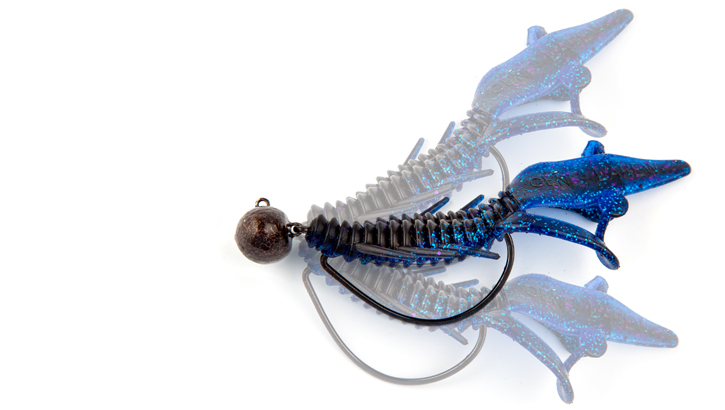
Introducing a successful, highly effective new lure to the market and relying on it for several top tournament finishes sounds like a scenario that’s purely positive for a professional angler. But for FLW pro Tommy Biffle, who designed the Gene Larew Biffle HardHead “articulated jig,” the success of his creation comes with mixed emotions … sort of.
“It’s ruined me,” Biffle jokes. “It’s about all I fish any more.”
Biffle’s excessive fondness for the HardHead, a football jig with a free-swinging wide-gap hook, stems from its ease of use and versatility.
“All you need to do is cast it out and bring it back along the bottom, bumping rocks or gravel or whatever is down there,” he explains.
Others in the industry have picked up on the effectiveness of the articulated jig, also known as a wobble head or wobble jig, which has made it a hot item in tackle stores and recently led several additional major manufacturers to create new models.
Here, we break down the details of the articulated jig and help you understand where it might fit into your arsenal.
Why it Works
What makes the articulated jig special is that the hook is joined to the head by a wire loop or a split ring, which allows the hook to be replaced. Either system leaves the hook and the trailer free to swing for unhindered action.
Any kind of movement – from the angler’s twitch of the rod tip to the soft push of current – is enough to make the entire plastic trailer move.
The trailer on a traditional football jig, by contrast, is somewhat restricted because the hook shank is firmly attached to the head. Only the trailer’s tails can move.
Most articulated jigs are rigged with a weedless hook, allowing them to be fished through rocky terrain and light wood cover without the need for a fiber weedguard. In fact, snags aren’t much of an issue unless the jig encounters “branchy” wood cover such as a brush pile, which isn’t typically as friendly, or if too heavy of a jig is used in shallow water.
Finally, an articulated jig can be fished slowly like a jig, but also on a steady retrieve like a crankbait. In the latter scenario, there’s seemingly no depth restriction (just increase weight when you increase depth), and the action can be altered by swapping the soft-plastic trailer.
To sum: It works because it’s versatile.
Where it Works
As mentioned above, an articulated jig can be fished just about anywhere a standard football jig or crankbait can be fished, but it excels on chunk rock banks when bass are on a crawfish binge, on windblown points in the fall, on flats and creek-channel edges, and on the deep ledges of the Tennessee River.
Tour pro Andrew Upshaw says it works well dead-sticked by letting the soft plastic move in a reservoir or river’s current. Upshaw also uses a small HardHead to fish above scattered grass.
Others uses include swimming it with a craw or swimbait trailer, bed-fishing, slow-rolling on deep structure, and slow-fishing with a finesse worm.
Ways to Rig It
Part of the versatility of the articulated jig is due to its ability to imitate so many types of forage when paired with the proper soft plastic.
Biffle’s go-to setup is to pair his namesake HardHead with his other namesake lure, the Gene Larew Biffle Bug, which is a bug-type creature bait with paddle claws that wobble on a straight retrieve. The Biffle Bug was designed to provide as much movement as possible. The combination of the two fished slowly along bottom has led Oklahoma bass fishermen to describe this bottom-scrubbing technique as “bugging.”
Other soft-plastic craws and creatures can be subbed for the Biffle Bug, depending on the profile size and amount of action desired. For instance, the Zoom Brush Hog is a good match for an articulated jig. It’s narrow worm-like body hides the hook but doesn’t impede hooksets, while all of its appendages flail around when put in motion.
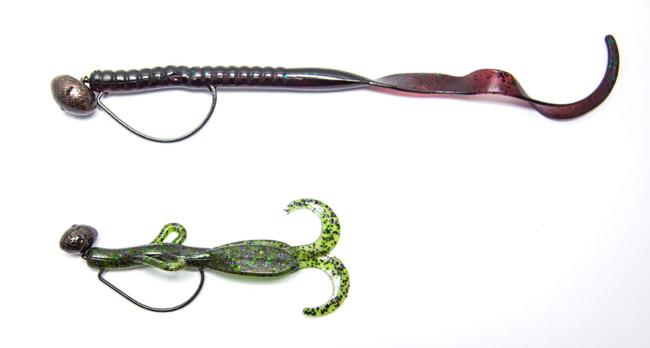 Sam Lashlee of Camden, Tenn., is a guide and tournament angler who lives on the Tennessee River. His preferred articulated jig for fishing big soft-plastic worms is the Strike King Jointed Structure Head. He pairs the 3/4-ounce model with the 7-inch Strike King Ocho soft stick bait or the 10-inch Strike King Rage Tail Thumper Worm.
Sam Lashlee of Camden, Tenn., is a guide and tournament angler who lives on the Tennessee River. His preferred articulated jig for fishing big soft-plastic worms is the Strike King Jointed Structure Head. He pairs the 3/4-ounce model with the 7-inch Strike King Ocho soft stick bait or the 10-inch Strike King Rage Tail Thumper Worm.
Dragging “big worms” has been a go-to summertime tactic on the Tennessee River for many years. With the articulated jig, the worm can be dragged, reeled slowly along bottom, or stroked up and down.
“It’s a weapon,” Lashlee says. “It’s my go-to.”
On the finesse side, Upshaw’s favorite rig is the small 3/16-ounce HardHead fitted with 3 1/2-inch Biffle Bug. Or for swimming around grass, he rigs the same head with a small finesse worm.
One final option for an articulated jig is a swimbait, which pairs especially well with bullet-shaped jig models. The free-swinging nature of the hook provides one extra level of insurance against bass leveraging themselves free during the fight. Just make sure the hook is big enough for the swimbait you choose to use.
In the Details
Now that more companies have released their own versions of the articulated jig, there are options for anglers who aren’t willing to settle for one do-it-all model.
Articulated jigs with pointed heads have shown potential around grass and some wood cover, or for dock-fishing, while the football head is still the top choice for rock and gravel.
Some jigs have a flattened bottom that slides along bottom and perhaps making them more capable of skipping. Others have recessed line ties.
Again, most of the jigs follow the same routine as far as construction. Generally, the loops for both the line tie and hook attachment are simple stainless wire. However, some companies are beefing up those wires for big-bass applications. It might pay to compare wire size if that’s a sticking point for your big-fish exploits.
Set the Hook
Because articulated jigs are often fished with a slow, steady retrieve, bites are often somewhat abrupt – less of a “tap-tap” or “thunk” and more of a sudden stop. The initial reaction is usually to rush and swing too quickly.
Try to reel up any slack until you feel the line start to tighten, then drive the hook home. It’s important to generate some force, especially when using a heavy jighead and bulky plastic.
Heads to Consider
 Gene Larew Biffle HardHead – This is considered to be the original articulated jig, if not for being the first one on the market, but for being the most successful early on. With its football head and wicked-sharp Owner hook, it excels on almost all types of bottoms. It’s offered in five sizes. Two-packs sell for $5.99. genelarew.com
Gene Larew Biffle HardHead – This is considered to be the original articulated jig, if not for being the first one on the market, but for being the most successful early on. With its football head and wicked-sharp Owner hook, it excels on almost all types of bottoms. It’s offered in five sizes. Two-packs sell for $5.99. genelarew.com
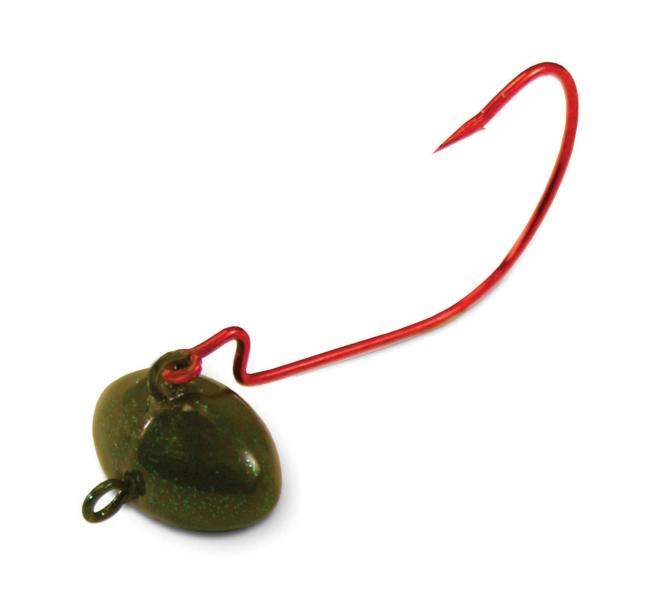 Bombshell Jiggy Head – The Jiggy Head has a football-shaped lead-head, providing a stable footprint for dragging. It’s available in 1/4, 3/8 and 1/2 ounce in green pumpkin with a wide-gap, red 4/0 hook. MSRP is $5.99. bombshelllures.com
Bombshell Jiggy Head – The Jiggy Head has a football-shaped lead-head, providing a stable footprint for dragging. It’s available in 1/4, 3/8 and 1/2 ounce in green pumpkin with a wide-gap, red 4/0 hook. MSRP is $5.99. bombshelllures.com
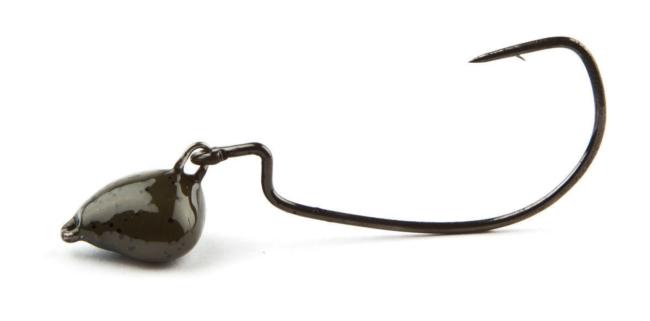 Strike King Jointed Structure Head – This model works well as a swim jig because the line tie is at the very nose of the jig, but it’s also a good choice for sliding through grass and wood. It comes in six colors in 3/8, 1/2 and 3/4 ounce. Price is about $5.50 for two. strikeking.com
Strike King Jointed Structure Head – This model works well as a swim jig because the line tie is at the very nose of the jig, but it’s also a good choice for sliding through grass and wood. It comes in six colors in 3/8, 1/2 and 3/4 ounce. Price is about $5.50 for two. strikeking.com
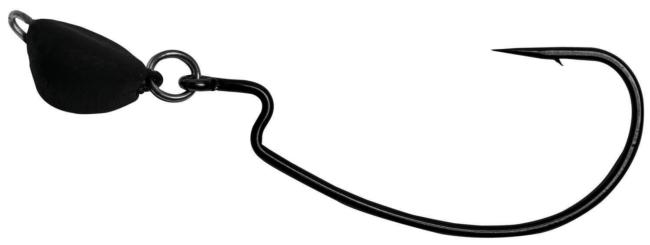 Owner Pivot Head – This is, perhaps, the smallest articulated jig on the market, with sizes ranging from 3/4 ounce all the way down to 1/8 ounce. Its bean-shaped head and hook are connected by a split ring. Choose either a weedless or straight-shank hook. Two-packs are $7.00. ownerhooks.com
Owner Pivot Head – This is, perhaps, the smallest articulated jig on the market, with sizes ranging from 3/4 ounce all the way down to 1/8 ounce. Its bean-shaped head and hook are connected by a split ring. Choose either a weedless or straight-shank hook. Two-packs are $7.00. ownerhooks.com
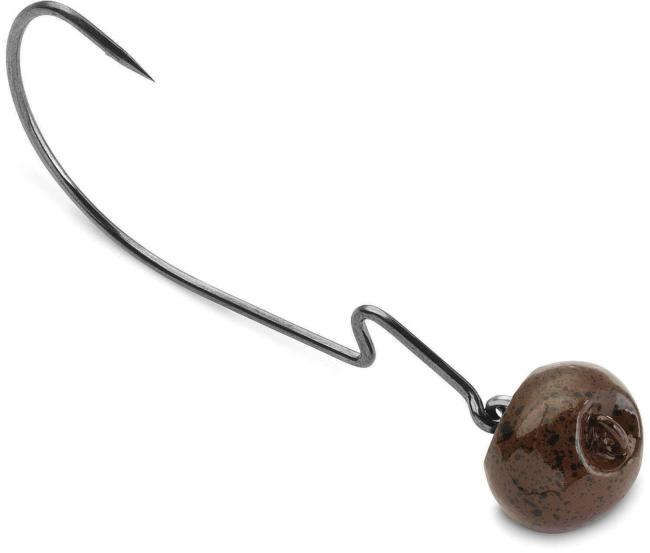 VMC Swinging Rugby Jig – The Swinging Rugby Jig has a football-shaped head with a recessed line tie that provides extra protection for lighter lines. VMC lengthened the hook shank in front of the bend for rigging jumbo plastics. It’s available in 1/4 to 3/4 ounce with a flattened bottom. You get two for $5.99. rapala.com
VMC Swinging Rugby Jig – The Swinging Rugby Jig has a football-shaped head with a recessed line tie that provides extra protection for lighter lines. VMC lengthened the hook shank in front of the bend for rigging jumbo plastics. It’s available in 1/4 to 3/4 ounce with a flattened bottom. You get two for $5.99. rapala.com